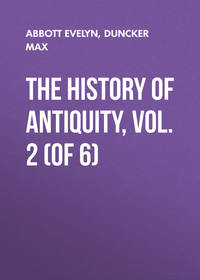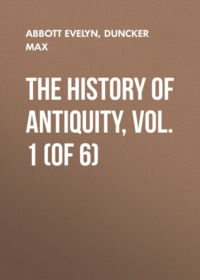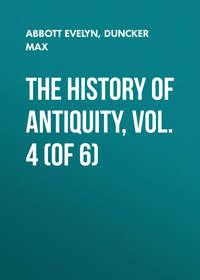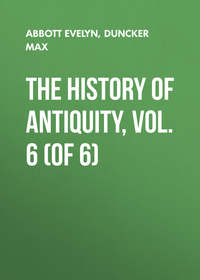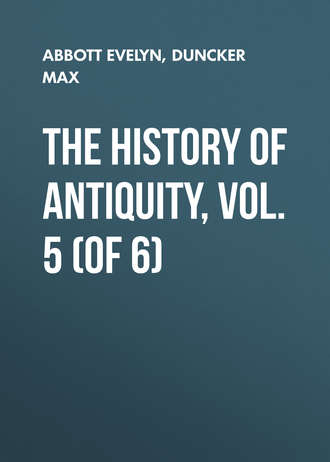 полная версия
полная версияThe History of Antiquity, Vol. 5 (of 6)
Temples and images are unknown to the Avesta. The reform preserved for the nations of Iran the traditional form of worship without images, on which it was founded. The accounts of western writers, from Herodotus and Xenophon downwards, establish the fact that there were only sacrificial places on the heights and consecrated fire-altars in Iran.283 But this must not be taken to mean that the forms of worship and the images of the nations with which the Persians became acquainted after the foundation of their supremacy, especially of their nearest neighbours, the Semites on the Tigris and Euphrates, remained without influence on them. On the monuments of Darius we see the picture of Auramazda, cut exactly after the pattern which the Assyrian monuments exhibit in the portraiture of their god Asshur. We are also told of images of Anahita. Berosus maintains that Artaxerxes Mnemon erected statues to Aphrodite Anaitis at Babylon, Ecbatana, and Susa, and taught this form of worship to the Damascenes and Lydians.284 From this statement, taken in connection with the account of Herodotus that the Persians had learnt to sacrifice to Mylitta,285 the conclusion has been drawn that Artaxerxes II. introduced the worship of Bilit among the Persians. But it was not necessary to teach this worship to the Damascenes and Lydians (I. 358, 563), and even in the Avesta, Anahita as the goddess of the heavenly water is the goddess of fertility. Hence the statues made by Artaxerxes were, no doubt, images of Anahita the goddess, whom he invokes along with Auramazda and Mithra in his inscription at Susa. Strabo describes the worship of the Magians at the fire-altars of Cappadocia in a manner which completely agrees with the accounts given in the Avesta, and then adds that these functions were also performed in the enclosures (σηϰοί) which were consecrated there to Anaitis, Amardatus, and Omanus, and the image of Omanus was carried round in processions. He concludes with the words: "this (i. e. the form of worship described) I have myself seen."286 According to this account, then, Amardate,287 i. e. the Amesha Çpenta Ameretat, who averts death, was worshipped there beside Anahita, and Omanus, i. e. the Amesha Çpenta Vohumano, the protector of the flocks, had an image. As this is all that we can discover about the image-worship of the Persians, it is clear that the influence of the picture-worship of Hither Asia and Egypt had no great influence even on the western nations of Iran. It is limited to the facts that Darius added the symbolical picture of Auramazda to his inscriptions without, however, building him a temple; that a century after him Artaxerxes II. erected statues and a temple to Anahita at Ecbatana; and that at a later time a portable image of Vohumano was in existence in Cappadocia.
The nucleus of the old religious conceptions of the Arians – the desire to obtain increase and life from the gods – has been sufficiently disclosed; and that which could not be obtained in this world, the continuance of the individual life, heaven was to bestow upon them. This line was followed up by the reform; the spirits of health and long life were added by the priests to the circle of the Amesha Çpentas. When Zarathrustra had increased the means for the protection and support of life; when it became a fixed maxim that purity preserved life in this world and ensured it after death; the sharp insistence on the command of the pure and active and truthful life which men ought to lead in this world, became developed into the conception of a judgment on the souls after death. He who had lived purely, and given the Daevas no room to exercise their power on his body, became himself pure and bright, and could therefore enter after death as a pure spirit among the spirits of light. Thus the Avesta announces that "when body and soul have separated," the soul on the third night after death, as soon as the brilliant sun arises, and the victorious Mithra seats himself with "pure brilliance" on the mountains, comes over the Hara berezaiti to the bridge of Chinvat, i. e. the bridge of assembly or of assembling, which leads to Garonmana, i. e. to the dwelling of hymns, the abode of the good gods. Here the Daevas and the gods contend for the soul;288 the judgment of the souls takes place;289 here Auramazda asks the souls about their conduct.290 The pure soul, whose odour the Daevas dread,291 which approaches with virtue and sanctity, is joined by the other pure souls and by the souls of the dogs which keep watch over the bridge of Chinvat,292 and the host of the heavenly Yazatas brings the soul of the good over the bridge into heaven. In contentment the pure soul goes to the golden throne of Auramazda, to the thrones of the Amesha Çpentas, to the dwelling of the pure. And Vohumano rises from his golden throne and inquires of the pure one: "How hast thou, O pure one, come hither out of the perishable to the imperishable world?"293 But the souls which come to the bridge full of terror and sick, find no friend there; the evil spirits, Vizaresha by name, lead them bound down into the place of the bad, into the darkness, the dwelling of the Druj.294
In the Veda the spirits of the fathers are invited to the sacrificial meal; they are to enjoy the gifts which are laid for them on the grass, to support the prayers of their descendants, to keep away the evil spirits, and to increase wealth. Each day water was poured there for the forefathers, and corns of rice were scattered for them; on the new moon the clans held the funeral feast for the dead; and we are acquainted with the consequences which attended expulsion from this banquet.295 The belief in the spirits of the ancestors, and their continued relation to their descendants, existed also among the Arians of Iran, and the Avesta alters it only so far as to limit consistently the assistance given by the spirits of the fathers to the souls of those who have lived in truth and purity, and have thus found entrance into heaven. According to the Avesta the Fravashis of the pure – this is the name given to the Pitaras, or fathers of the Indians – protect their descendants against the Daevas, help them in distress and danger, and fight for their families on the day of battle, if they are honoured and satisfied by their descendants. It is only an old conception, repeated in the Avesta, when we are told: "We invoke the good, strong, holy Fravashis. Where strong men fight in severe conflict, there come the Fravashis with strong shield, iron helmet, and iron weapons; with Mithra and the victorious wind they go forward; strong warriors against the enemies, they are mighty saviours; strong conquerors, they destroy the victory of the enemy – the Turas (Turanians)."296 It is due to the additions and modifications introduced by the priests that we hear that the hosts of the Fravashis watch the body of Kereçaçpa till the resurrection, and the seed of Zarathrustra, and protect the sleepers from the rising of the stars till midnight.297 As among the Arians of India the ancient belief in the fathers was retained in spite of all changes of the religious system, so also in Iran. At the close of the year, on the intercalary days which were added to it, the Fravashis come to their families, abide among them for ten nights, and ask: "Who will receive us, and sacrifice to us, and praise us?" and "if any one offers to them prayers and flesh and clothes, him they bless, and in his dwelling there will be abundance of oxen and men, swift horses and a strong car."298 The Greeks had therefore reason to say that according to the doctrine of the Magians the air was full of spirits.299
In another direction the system of the priests deviated far more widely from the ancient conception of the spirits of the ancestors. They held that only the pure and bright part of the soul could live on after death. Hence, even in the living they distinguished this part from the polluted part, and in the pure immortal half they saw the side created by the good gods, its true being, the Fravashi or protecting spirit allotted to each man. In the Avesta therefore rules can be given for the invocation of this pure part and nature of the individual soul, of the separate Fravashis. The priests then transferred this notion to the heavenly spirits, and even to Auramazda himself. His purest nature, his best self, must be praised and invoked for aid. Auramazda says to Zarathrustra in the book of the law: "O Zarathrustra, praise thou my Fravashi, the Fravashi of Auramazda, the greatest, best, most intelligent, best-formed, highest in holiness, whose soul is the holy word."300 And in the prayers we are told: "We praise the Fravashis of the Amesha Çpentas, of the holy Çraosha, of Mithra, together with all the Fravashis of the heavenly Yazatas. I invoke the Fravashi of the holy Zarathrustra, the Fravashis of the men of the ancient law, and the Fravashis of the men of the new law, the good mighty Fravashis of the pure, of the nearest relations, and of my own soul."301 The Persians at the king's gate, according to the Greeks, set apart a separate table at each meal with bread and food for the "demon" of the king, and at a Persian banquet the host, according to Plutarch, calls on his guests, "to honour the demon of king Artaxerxes." Hence it clearly follows that the priestly doctrine of the Fravashis of the living was current even in Western Iran under the Achæmenids.302
Zarathrustra had increased the means for keeping off the evil ones, and had made the struggle against the wicked spirits easier for men. But the time will come when the struggle will be no longer necessary, and the bright spirits alone will rule. This doctrine is indicated even in the Gathas.303 In the book of the law Zarathrustra says to Angromainyu: he will smite the Daevas till Çaoshyant is born from the water of Kançava in the eastern region.304 Çaoshyant, i. e. the useful, the saviour, is called in the Avesta, "the sublime, the victorious;" he will smite the Druj, and Aeshma will bow before him. He will make the world to live for ever, without age and death; the dead will rise again, and the living will be immortal. Vohumano will smite Akomano, Asha will kill the lies. Haurvatat and Ameretat will destroy thirst and hunger: "The evil-doer Angromainyu, robbed of his dominion, bows himself."305 This doctrine of the Avesta also was well known to the western world. In Herodotus Prexaspes tells Cambyses that when the dead rise again he will see Smerdis and Astyages.306 Theopompus of Chios tells us: Zoroaster had proclaimed that there would be a time in which the dead will arise, and men will be immortal, and everything will be done by their invocations. Last of all, Hades will pass away; men will then be happy; they will need no nourishment, and throw no shadows, and the god who will accomplish this rests for a time, but not a long time for a god.307 It is true that men required no nourishment when Çaoshyant had appeared, in the meaning of the Avesta, for Haurvatat and Ameretat had overcome hunger and thirst as well as sickness and death; and as the dark side of man was taken away, and only the bright side remained, they could not cast any shadows.
As already remarked, it was part of the duty of the priests to bring the ancient legends of the old time into harmony with the new doctrine. We saw that the legends of Iran began with the happy age of Yima, and his reign of a thousand years full of increase and blessing. This conception of a perfect age for the creatures of earth at the very beginning of things did not suit with the struggle, which, according to the new doctrine, Angromainyu commenced immediately after the creation. The priests, therefore, conceived the beginning of things in a different manner. In their system Auramazda first created the heaven, then the water, then the earth and the trees, and after these the four-footed bull, and the two-legged pure man Gayo maretan.308 In the Avesta the primeval bull and man are at the head, and time extends from Gayo maretan to Çaoshyant.309 The books of the Parsees then tell us that Angromainyu killed the primeval man and bull, but from the seed of the bull proceeded a pair of oxen, and then all kinds of good animals; and out of the seed of Gayo maretan grew up the first man and the first woman. As we have already remarked, our fragments of the Avesta identify the soul of the first created bull with the Drvaçpa, the ancient guardian spirit of the flocks; next to Gayo maretan they place Haoshyangha, the Paradhata (p. 36), and represent him as sacrificing to Ardviçura, Vayu, and Ashi vanguhi, in order to obtain the dominion over the evil spirits.310 After him Takhmo urupa rules the earth of seven parts; he sacrifices to Vayu in order to obtain grace to restrain Angromainyu for thirty years.311 Then, according to the system of the priests, follows the dominion of Yima the son of Vivanghana, during which there was no cold and no heat, no age and no death, as was represented in the old views. Yima kindles the red-glowing fire. Flocks and men, i. e. life, increase; and the earth must be made larger. The end of this happy period, and the death of Yima, is brought about, according to the priests, by the fact that Yima refused to be the preacher of the doctrine of Auramazda, that he was unable to maintain purity and truth, and began to "love lying speech" (p. 41). As Yima was born to Vivanghana as a reward for his Haoma sacrifice, there follows a series of those who have offered the sacrifice: Athwya, Thrita, Pourushaçpa, and their sons. To the first Thraetaona was born, who smites the serpent Dahaka; to Thrita Kereçaçpa, who smites the serpent Çruvara; and to Pourushaçpa was born Zarathrustra, who receives the law of Auramazda and proclaims it; by this law the Daevas will be warded off till Çaoshyant appears, when everything which has once had life will come to life again.
CHAPTER VIII.
THE PRIESTHOOD OF IRAN
In the form in which we have them the books of the Avesta are the work of the priests of Eastern Iran. According to the evidence repeatedly furnished by them, there were three orders in Sogdiana and Bactria: priests, warriors, and husbandmen. This sequence, which is uniformly preserved both in the invocations and in the book of the law, shows that the priests had risen above the warriors, and claimed to be the first of the three orders.312
In considering the civilisation of the Bactrian kingdom we found ourselves compelled by the proximity of the nations of the steppes to assume, that when the Arians had become established there, the tribes which had a capacity or love for battle, undertook the protection of the land, the flocks and fields, against the incursions of the nomads of the north, and made battle and strife their special vocation. Such attacks increased with the increasing culture of Bactria, and led to a consolidation of powers; these clans raised one of their number distinguished in battle to be their leader, or followed him, and thus was laid the basis for the foundation of a great state. The importance ascribed in the Avesta to the splendour of majesty – we find the personification of good government in the Avesta among the Amesha Çpentas – in combination with the battles which, as we learn from the book, the princes of Bactria carried on against the Turanians, and with the statements in the West Iranian Epos about the kingdom of the Bactrians, together with the later condition of the country, allowed us to draw the conclusion that at one time the kings of Bactria were not without power and importance. They reigned, surrounded by the families of the warriors, who were enabled by their possessions in lands and flocks, to devote themselves to the practice of arms and to battle. The invocations to Mithra, Verethraghna, and Vayu, bear upon them very evident traces of a war-like spirit (p. 110, 114). That the spirits of the sky, which once fought with the cloud-dragons, have become mortal heroes in the Avesta, also proves – since even among other nations the Epic poetry which follows periods of warlike excitement transforms shapes of the sky into heroes of old time – that once on a time Bactria had experienced a period of warfare, when difficulties arose which it was mainly the business of the monarchy and the nobles to settle. The Avesta can tell us of arms and robes as well as of palaces with pillars and turrets; of earthen, iron, silver and golden vessels; of mats, carpets, and adornments of gold,313 such as are found among noble families; and those hecatombs of horses, cattle, and sheep which the heroes in the Avesta sacrifice to Anahita and Drvaçpa, in order to obtain their favour by victory, are no doubt borrowed from the sacrifices which princes and nobles were wont to offer in cases where the numbers must be enlarged in honour of the heroes. Yet we see that Xerxes orders a thousand oxen to be sacrificed at one time. We have already shown (IV. 390), how important and pre-eminent was the position which the races of the warriors, "the princes," occupied on the Indus and the Ganges, and what respect they commanded among "the free Indians" in the Panjab, even in the fourth century B.C. That a warlike nobility of a similar character, attitude, and position, existed in Eastern Iran, is the less to be doubted, as the order of warriors in the Avesta is denoted by a name (rathaestar) which goes back to the chariots of war. The husbandmen, who were settled beside and among them, bear in the Avesta the name of Vaçtrya,314 but the word Vaeçu is also used for them, which simply repeats the name of the Indian Vaiçyas.
Like the Arians of India, the Arians of Iran believed in the power of the correct invocations, prayers, and sacrifice; among them also the sacrifice strengthens the gods and increases their power. In India too, the priests, and minstrels, and sacrificers handed down in their families the knowledge of the effective invocations and ceremonies which exercised compulsion on the gods, and the same was the case in Eastern Iran; priestly families arose at a very early period. They did not here retain the name of supplicators, as in India; but are called Athravas in the Avesta. In the Veda Atharvan kindles the sacrificial fire, and among the Arians of India the incantations of the race of Atharvan passed from the most powerful. In a similar way powerful invocations and sentences were handed down in Iran from father to son in the race of the Athravas. These families preserved the ancient invocations to Mithra, Verethraghna, Anahita, Tistrya, which are preserved to us in the Avesta, though in a modified form. The god Haoma instructs Zarathrustra to praise him, as the other fire-priests had done (p. 124). The reform which bears the name of Zarathrustra cannot have left the condition of the priests unchanged. The doctrine may, as invocations in the Avesta would seem to show, have first found adherents in the race of Haechataçpa, to which Zarathrustra belonged, and to which he first proclaimed his law (131), and next in the race of Jamaçpa and Frashaostra, who are spoken of as Zarathrustra's most zealous followers. According to the creed of the Parsees the good law also came to Aderbat Mahresfant by family descent (p. 62). These new races of priests, who knew the sayings, invocations, and prayers of Zarathrustra, would then be joined by those among the races of the old fire-priests who approved of the reform, and the priesthood thus formed would be further strengthened by those who, deeply impressed by the new doctrine, sought and found reception as pupils into a family of the priests, thus entering into their circle, and becoming members of their families. United by a new doctrine and settled tenets, the priests who represented the reform would become united together more firmly than the priestly families of the old time.
The priesthood could very well claim precedence of the warriors; on their prayers and sayings, their knowledge of the custom of sacrifice, depended the favour of the gods, the power of averting evil spirits, the removal of pollution, salvation in this world and the next. Yet they could not obtain such a position as the Brahmans held on the Ganges after the reform of the ancient faith, and the victory of Brahman over Indra. For in Iran there was no order of Çudras, no vanquished remnant of an old population, which created a sharp line of division even among the orders of the Aryas; and moreover the Brahmans were the first-born of Brahman, a purer incarnation of the divine nature than any other order. The world had not emanated from Auramazda; there were in Iran no gradations of beings in which the divine essence existed in a more or less pure condition. All had to fight against evil deities and against evil; the priests were the leaders in this struggle – this leadership and nothing more could they claim. In their lives they studied especial purity of body and mind; and they were pre-eminently "the pure men." Only by their means, at any rate with their assistance, could sacrifice be offered; from their mouths alone could the correct invocations be uttered to the gods, and the evil ones be driven away. Men were compelled to submit to the rules of the life acceptable to the gods of light, of pure conversation, which were accurately known to the priests only; they had to take upon themselves the expiations which the priests prescribed, in order to wipe out offences and sins and their consequences – but they had not to reverence in them, as was the case beyond the Indus, a class of creatures raised by birth to a higher level. Hence the sharp separation of the priesthood from the rest of the orders, in the Brahmanic fashion, was at once placed out of the question. The priesthood of Iran perpetuated their knowledge and wisdom in their families; but they had not the right to bar all entrance into their families or their order on the score of higher birth, or to prohibit the marriage of priests with women of other orders, on the ground of their superior nature.
From our fragments of the Avesta we may assume that although, as is obvious, the precedence of the priests above the remaining orders was strongly marked, and they were especially denoted as "pure men," the limits of their political and social position were far more modest than those of the Brahmans. So far as we can see, the Avesta allots no special income to the priests beyond the camels, horses, or small cattle given to them by warriors and husbandmen in quittance for the purifications they have performed. The penalties also which have to be paid in expiation of certain offences are to be given to "the pure men," and the Avesta repeatedly recommends the presentation of gifts to them. On the other hand, the priests do not possess the exclusive right to perform purifications. The Vendidad merely says that any one who wishes to perform purifications must have learned the law from one of the purifiers, i. e. it is only the instruction of the priest which is indispensable in this matter. Any one who performs purification without such instruction (except in the case of necessary purifications, p. 230), will take away from the places where it is performed, "food and fatness, health and all remedies, prosperity, luxuriance and growth, and increase of corn and fodder; and corn and fodder will not return to such places until for three days and nights the holy Çraosha has been praised at the burning fire with bound withes and uplifted Haoma." The uncertified purifier is to be put in chains, his clothes taken from him, and his head cut off.315 If it was permitted to learn the purifications, it follows that men not of priestly descent could enter the order of the Athravas, and the boundary line between this order and the rest was not impassable. Among the Parsees of India any one can become a priest. The duties of the priest, according to the book of the law, consist in watching and tending the sacred fire, in praising the good spirits, in offering sacrifice, and performing purifications, and in the ceaseless study of the holy scriptures. The priest is to be provided with a mortar made according to certain rules, a cup (for the Haoma sacrifice), the snake-switch (a stick for killing impure animals), and the Paitidana, i. e. a piece of cloth for veiling the mouth, in order that he may not approach the sacred fire with breath that is possibly impure. For the rest, the Vendidad lays down the rule that the priests are to be patient and content, and satisfied with a little bread, and they ought to eat what is offered to them.316 Auramazda says; "Many men, O Zarathrustra, carry the Paitidana, the serpent-switch, the sacred bundle of twigs, without being guided according to the law. These are wrongly called priests; do not thou call them priests, O Zarathrustra. He who lies the whole night without praising or hearing, or reciting, or learning, or teaching – call not such an one a priest. Call him a priest, O pure Zarathrustra, who inquires of the pure intelligence the whole night, of the wisdom which purifies from sins and makes the heart wide, which has merits in store on the bridge of Chinvat, and causes us to attain the purity and bliss of Paradise."317 The Avesta distinguishes different classes of priests, but the distinction only rests on the various acts which they perform in the sacred rites. The first rank is taken by the Zaotar, who utters the prayers and invocations (the Hotar, i. e. the Repeater of the Veda); next to him apparently is the Çraoshavareza, "who speaks very wise and truthful things;"318 he bears the club of Çraosha, in order to keep the evil spirits at a distance from the sacred acts; then comes the Atarevaksha, i. e. the priest who causes the fire to increase, and attends to the worship of it; then the Açnatar (the Washer), who has to cleanse the instruments of sacrifice to keep them from pollution; the Frabaretar, i. e. the Carrier, etc. In the modern ritual of the Parsees all the duties of the sacred service have been transferred to the Zaotar and the Raçpi, which latter discharges the functions of ministering priest.


